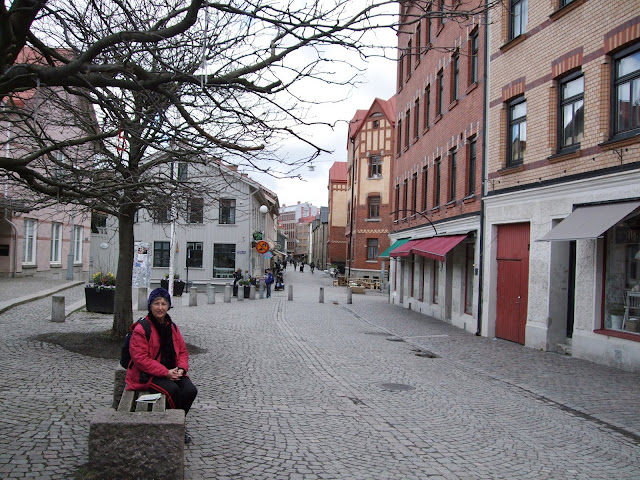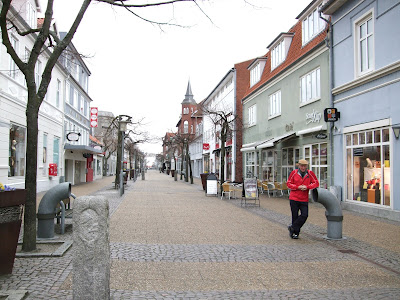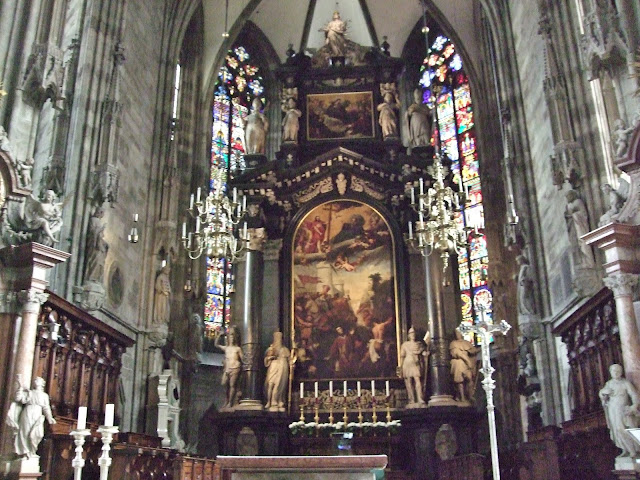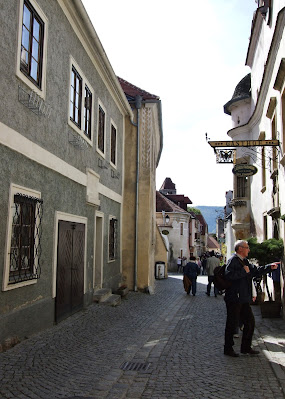https://joyolneyfamily.blogspot.com
Scandinavia & Eastern Europe - April/May 2012
We were away for a month on this trip. On 10 April we flew to Helsinki for 3 days. A dream came true as snow was on the ground. Train across Finland to catch an overnight ferry to Stockholm. Another dream came true as snow fell for about 12 hours. After 3 days in Stockholm we trained across Sweden to Gothenberg for a 2 night stay. A ferry to Frederickshavn in Denmark for the night. Next day we caught a train for 7 hours to Copenhagen and stayed for 3 nights.
We flew to Helsinki and onto Budapest, where we joined a Blue Danube River Cruise with Avalon Cruising on "Imagery" for a week. Stops along the way included Bratislava, Vienna, Durnstein, Melk, Salzberg, Passau, Regensburg. We coached to Prague and visited Terezin Concentration Camp while there.
We took a train from Prague to Dresden and down to Bayreuth and Bamberg where we stayed with friends. A train to Nuremberg and flew out of Frankfurt for home.
(Refer to Scandinavia and Eastern Europe 2012 Blog).
Finland
 |
I had hoped we would get snow in Scandinavia.
As we flew into Helsinki I could see they had had a recent snow fall. |
 |
Helsinki (Lutheran) Cathedral built 1830-1852 overlooks Senate Square.
|
 |
Organ inside Helsinki Cathedral.
|
 |
Uspenski Cathedral built 1868. The largest Orthodox Cathedral in Western Europe. With its golden cupolas and red fasarde, the Church is one of the clearest symbols of the Russian impact on Finnish history. The interior of Uspenski reflects the Byzantine traditions of the Orthodox Church.
|
|
|
 |
| Interior Uspenski Cathedral, Helsinki. |
Temppeliaukio Church (Lutheran) is quarried out of natural bedrock. Open in 1969. The congregation sits within the quarry. The skylight roof has been very artistically done and mezzanine floor gives an overall view of interior.
 |
| National Museum designed in national romantic style and completed in 1916. |
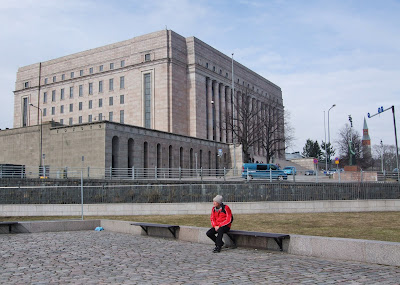 |
| Helsinki's Parliament House. |
Finland is a Republic and every 4 years Finns
elect Parliament. They have a Prime Minister.
The Bronze statues in Plenary Hall represent
"Settler, Intellectural work, Faiith & Harvester". We sat in Parliament for a while and later had
coffee in Little Parliament Building built 2004.
We took a tram out to the terminus and discovered a frozen sea and snow on the ground. Helsinki had a decent snowfall just a few days before we arrived. There was still frozen snow (ice) in sheltered places, even in the city centre of Helsinki.
The frozen sea (being tidal) goes up and down with the tide. It was starting to thaw along the coast.
 |
We took the Eurail through 5 Countries, validity 8 days within 2 months. We travelled 1st class and found it a very comfortable and convenient way to travel.
We travelled from Helsinki to Turku with snow countryside, arriving in Turku 2 hours later. We had a 5 kms walk along the canal to the ferry. "Europa" Silja Line departed at 8.15pm. We had a berth for overnight sleeping, arriving in Stockholm 6am the next morning. Many Finns sail overnight and back as a 24 hour holiday.
|
Sweden
 |
| When we arrived in Stockholm it had been snowing about 6 hours. We looked up and saw our Hotel - Scandic Ariadne. That was great, but with the snow we could still get very wet. Problem solved - there was a 450 metre covered walk way from the ferry terminal to hotel reception. Hardly a soul around, no-one in attendance in Customs so we walked straight through. We did not have to present our Passport when leaving Finland either. |
 |
| "Europa" docked in Stockholm with snow falling. |
 |
| We were given access to our room at 7.30am. It was still snowing and the sight was fantastic. Visibility was down to 500 metres. With the snow it looked like a ghost town. We could not go anywhere, but we were experiencing Stockholm. |
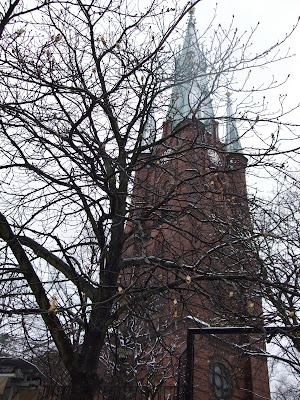 |
| Church of St Clare in Stockholm, built 1572. |
 |
Stadshuset's (City Hall) stately tower with bell is one of Stockholm's highlights - 106 metre high tower.
The City Hall was inaugurated on Midsummer's Eve 1923. |
 |
The Nobel Peace Prize is presented at Stadshuset (City Hall) on 10 December
every year with a Banquet.
More than 800 Laureates have been awarded the Nobel Prize,
all in accordance with the Will of Alfred Nobel.
|
 |
| Tomb of Birger Jarl, Stockholm's founder outside City Hall. |
 |
The large cloister between City Hall courtyard
and the area overlooking Gamla Stan - the old town centre. |
 |
| Gamla Stan - old town centre from City Hall. |
 |
| Riddarholmen Church were Swedish royalty are buried. |
 |
Gamla Stan is Europe's largest and best preserved medieval city
where Stockholm was founded in 12th century.
All the old Town is like a living museum, pedestrian friendly and charming. |
 |
| Gamla Stan - the old town. |
 |
| Kungstradgarden (King's Garden). |
 |
| Museum - collection of Mediterranean archaeological artefacts. |
 |
| Stockholm's Royal Opera House. |
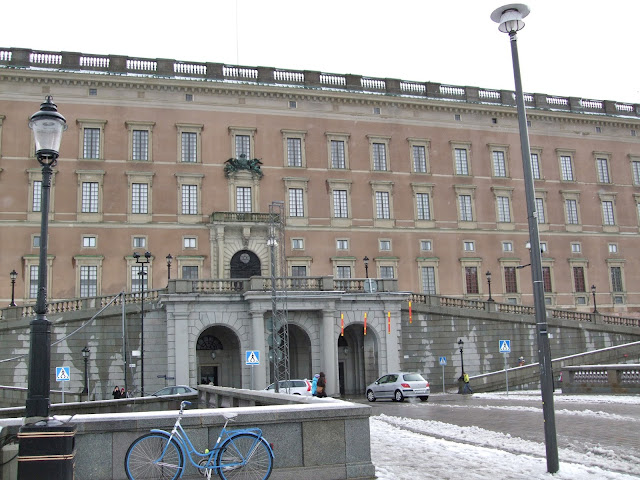 |
Royal Palace, one of the worlds largest inhabited palaces with more than 600 rooms.
Built primarily in 18th century.
The Royal Armoury, State Suites and various Museums are housed in the Palace. |
We walked for hours in -5 degree temperatures, but well worth it.
Now it was time to return to our Hotel by bus after a very exciting day on Stockholm.
 |
A ferry berthing outside our hotel.
What a contrast from this mornings weather. |
 |
The next day we went by train and bus to Drottningholm Palace.
Since 1981 the Swedish royal family have lived at Drottningholm.
The whole estate, including Court Theatre & Chinese Pavilion
is part of UNESCO's World Heritage programme. |
 |
| There was still snow on the grass. |
 |
| Drottningholm Palace, built 1662. |
 |
Nobel Museum.
Alfred Nobel (1833-1896) was a cosmopolitan with a background in St Petersburg, Stockholm and Paris. The Nobel Museum's aim is to spread knowledge and create interest around natural sciences. Alfred wrote in his Will that sciences, chemistry, physiology, medicine, literature & peace would each year receive a part of the revenues of his fortune. |
 |
| Stortorget, the site of Stockholm's bloodbath in 1520. |
 |
| Kungstradgarden (King's garden) without snow. |
 |
Using our Eurail ticket we went by train from Stockholm (east side of Sweden)
to Gothenberg (west side) - 3 hours 10 minutes.
Lots of coffee and cake complimentary as we were 1st class. |
 |
Gothenberg Railway Station.
We bought a 24 hours ticket and proceeded to Apple Hotel. |
 |
| Gothenberg Town Hall. |
 |
| Canal & lock in Gothenberg. |
 |
We made good use of our 24 hour ticket.
Dogs are allowed on all forms of transport, in theatres, shopping centres & ferries. |
 |
| When we woke the next morning we found it had snowed overnight. |
We walked through the Haga area of Gothenberg with its cobble stone streets.
 |
We visited Bamens Zoo in Gothenberg where visitors were able to have a hands on experience
with the animals (goats, sheeps, rabbits, pigs, chickens, ducks, ponies, deer).
The Zoo is located in a lovely bush land. |
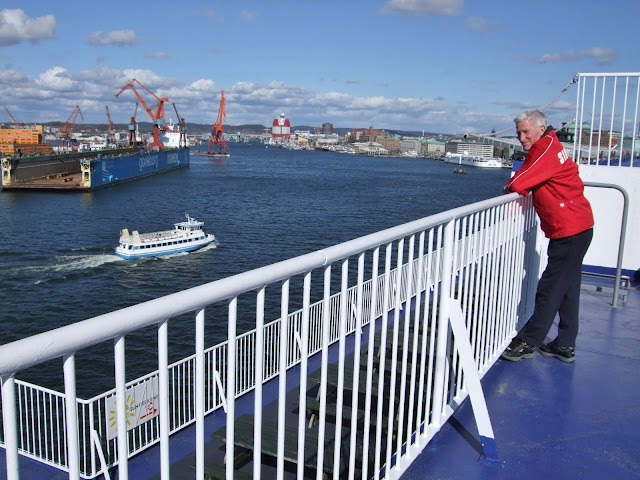 |
Still sunny but quite cold probably 5C.
At 4pm we caught a ferry with Stena Line and sailed 3 hours 15 minutes from
Gothenberg to Frederickshavn in Denmark. |
 |
| From on board our ferry to Denmark. |
Denmark
 |
Best Western Herman Bang in Frederickshauvn.
A lovely homely hotel with Danish furniture and dining room with character. |
A small town with lots of character and cobblestone streets.
 |
A 7 hours train trip from Frederickshauvn to Copenhagen.
The time went quickly with lots of people to talk to and plenty of activities.
Denmark was flat, farming and lots of wind farms. |
 |
| Arriving at Copenhagen Railway Station. |
 |
| Hundreds of bikes outside Copenhagen Railway Station. |
 |
| Hans Christian Anderson outside the Town Hall and opposite Tivoli Gardens. |
 |
| Hans Christian Anderson in Tivoli Gardens. |
 |
Copenhagen Town Hall with Astronomical Clock.
Bishop Absalon, the Founder of Copenhagen in gilded copper above the entrance. |
 |
Hojbro Square with Bishop Absalon on horseback.
He Founded Copenhagen in 1167. |
 |
| Christianborg Palace - Danish Parliament and Supreme Court. |
 |
Holmen's Church where Queen Margrethe 11 and Prince Henrik were married in 1967.
Princess Mary and Prince Frederik's twins Vincent and Josephine were christened in Holmen's Church. |
 |
| Nyhavn area in Copenhagen. |
 |
Joy at Amalienborg Palace where Princess Mary lives.
She is very popular and the family are often seen riding bikes,
and Mary drives the children to school in the car. |
 |
Amalienborg Palace has 4 large buildings joined with 4 smaller buildings,
thus forming an octaginal space for public to get close to the building.
We watched the changing of the Guards. |
 |
| Peter at Langelini Harbour with Pania from Hans Christian Andersen's fairytale. |
 |
We met Winnie in the Gardens.
A God appointment.
Winnie was about to go to Court so we prayed with her. |
 |
| Peter and Sir Winston Churchill having a chat in Copenhagen. |
 |
| Nyboder historic Navy row house district, built 1757. |
It was time for us to fly from Copenhagen to Helsinki and then onto Budapest for the next leg.
 |
16km car and train bridge and tunnel over and under Oresund Strait
between Sweden and Copenhagen. |
 |
Arriving in Helsinki we could see the lake was starting to thaw.
12 night Blue Danube River/land cruise from Budapest to Prague.
Budapest is one of Eastern Europe's oldest cities. On one side of the Blue Danube is Buda and Pest is on the other side. They became Budapest in 1873. Since the fall of the Iron Curtain, Budapest has emerged as one of the most desirable cities in Eastern Europe. It has fascinating historical heritage and flair.
|
 |
Funicular Railway and Tunnel in Budapest.
Railway was opened 1870, destroyed WW11& reopened 1986.
Length 95 metres, Height 51 metres, Gradient 48%. |
 |
Old Buda Palace was the home of Hungarian Kings, first completed in 1265.
Destroyed in WW11 and rebuilt 1966.
Today the old Buda Palace on Castle Hill contains the
Hungarian National Gallery and National Library & Museum.
Buda Castle was declared a World Heritage Site in 1987.
|
 |
| From the Funicular Railway entrance looking to the Chain Bridge across the Danube River. Intercontinental Hotel on far right. |
 |
| Holy Trinity Statue outside Matthias Church on Castle Hill. |
 |
Matthias Church where the Coronation of several Hungarians was held.
Originally built in Romanesque style 1015, Gothic style in 14th century
and extensively restored late 19th century.
Officially Church of our Lady, popularly named after King Matthias 1458. |
 |
Fisherman's Bastion built 1895-1902.
Nearly destroyed WW11, restored 1947-48.
Seven towers represent 7 Magyar tribes from 896. |
 |
| Fisherman's Bastion & Stephen 1 of Hungary erected 1906. |
 |
| A war damaged building that has not been restored. |
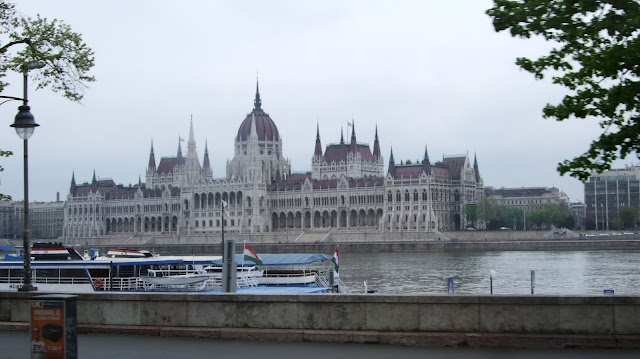 |
Parliament House, one of Europe's oldest legislative buildings.
Constructed started 1885, inaugurated 1000th anniversary of the country in 1896,completed 1904. During Communist rule there was a red star on the dome.
Declared Hungarian Republic 23 October 1989. |
 |
| Buda Palace on Castle Hill from our Hotel. |
 |
| Opera House built in 1884. |
 |
Hero's Square completed 1900.
The Cenotaph is dedicated to heroes who gave their lives for the freedom of people
and national independence. Column topped by archangel Gabriel.
Base of column has 7 mounted figures representing the Magyar Chieftains 896AD. |
 |
Memento Park was opened 1991 to house these statues from the Communist Period 1949-1989.
Statues of Lenin, Marx, Engels. |
 |
Peter at Statue Park.
After the fall of Communism these statues were placed in this park,
not to honour, but to remember it was part of Hungary's history. |
 |
"House of Terror" is a memorial to the victims of fascist and communist regimes, including those detained, interrogated, tortured or killed in the building. The Museum opened 2002 but it was witness to two shameful and tragic periods in Hungary's 20th century history. In 1944, during the gruesome domination of the Hungarian Arrow Cross Party, this building, known as the "House of Loyalty", was the party headquarters of the Hungarian Nazis. Then between 1945 and 1956, the notorious communist terror organisations, the AVO and its successor, the AVH, took up residence here. 60 Andrassy Boulevard has become the house of terror and dread. |
 |
A Solemn and unobtrusive memorial to Holocaust victims,
who were told to take off their shoes, were shot and fell into the Danube River during WW11. |
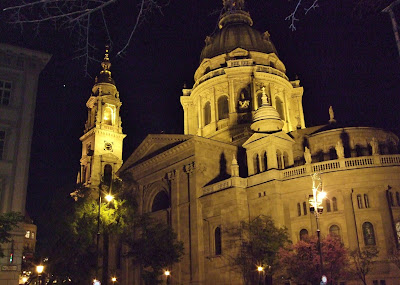 |
| St Stephen's Cathedral. |
 |
| Franciscan Church of Pest. |
 |
Buda Palace on Castle Hill from Chain Bridge, just near our Intercontinental Hotel.
|
After 2 days in Budapest we cruised for 7 days up the Blue Danube on Avalon's "Imagery".
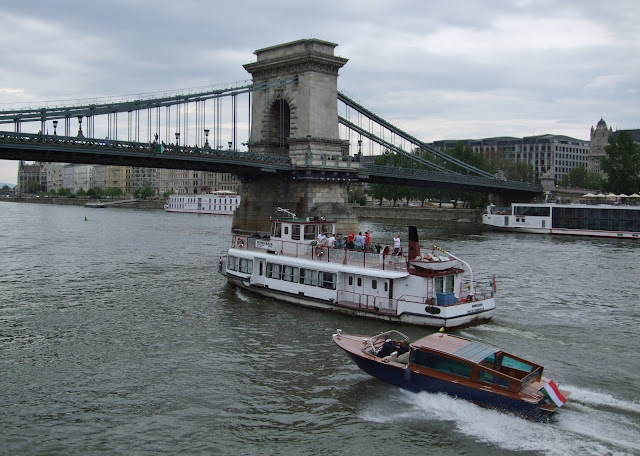 |
| Cruising under the Chain Bridge in Budapest. |
 |
| Dinner. |
 |
| MS Imagery dessert. |
We ventured through 17 locks. A lock has gates at each end. With both gates closed, water level within the lock is adjusted to match the river water level outside of the lock. It takes about 20 minutes for the water level to rise in the lock.
 |
| Lock behind our vessel with gate closed. |
 |
Not much room to spare in the lock
but there is room for 2 vessels to go through a lock beside each other. |
 |
| Water in lock continues to rise. |
 |
| Lock water level has risen equal to the river water so the vessel can proceed forward. |
Bratislava, Slovakia.
 |
War Memorial for Soviet soldiers
who liberated the city from Germans in WW11. |
 |
Bratislava Palace built 9th-18th century. Rebuilt 1956-1964.
Now Slovak National Museum. |
 |
| Bratislava. |
 |
Mozart conducted his first public concert in 1762, aged 6 in Palffy Palace.
Now Austrian Embassy. The cream building with the Austrian flags far right. |
 |
Bratislava, Slovakia was a little more than a battlefield for the ambitious
Hungary, Austria & Turkey empires for many centuries.
Bratislava became the capital of Slovakia in 1993. |
 |
| "The Watcher" in Bratislava. |
 |
Bratislava's Town Hall is a complex of buildings from the 14th century.
Town Hall built 1370. Today it is a Museum.
Window above the Old Town Hall is the entrance to Bratislava. |
 |
Street to St Martin's Cathedral & Chapel of St John the Merciful.
|
Vienna, Austria
 |
Schonbrunn Palace was built in 1642. It has 1141 rooms and we saw 20 of them!
The summer palace of the Hapsburb family. |
 |
| Gloriette at the end of the Gardens. Destroyed WW11, restored 1947. |
 |
Where ever we went there were men who had won the heart of their woman.
Peter was fascinated by these sculpture. |
 |
We went to an Apple Strudel demonstration. We enjoyed coffee and guess what?
In 2015 we visited friends Ruth & Bob Runkle in Arizona, USA. |
Durnstein, Austria
 |
| "Imagery" berthed in Durnstein. |
 |
Durnstein with castle ruins where Richard the Lionheart was imprisoned
December 1192 - March 1193.
King Richard 1 of England (1157-1199) reigned from 1189 until his death of gangrene in 1199. |
 |
The towns legend says that the hangman had to live at the far end of town
as people were not sure how to relate to him.
He lived in the pink house with crucifix outside. |
Durnstein is in the wine region of Wachau Valley.
There were many opportunities for wine tasting and
Schnapps tasting as we wandered around this lovely quaint village.
Some of the houses date back to the 16th century. One can only live in Durnstein if you were born in Durnstein.
Melk Abbey, Austria.
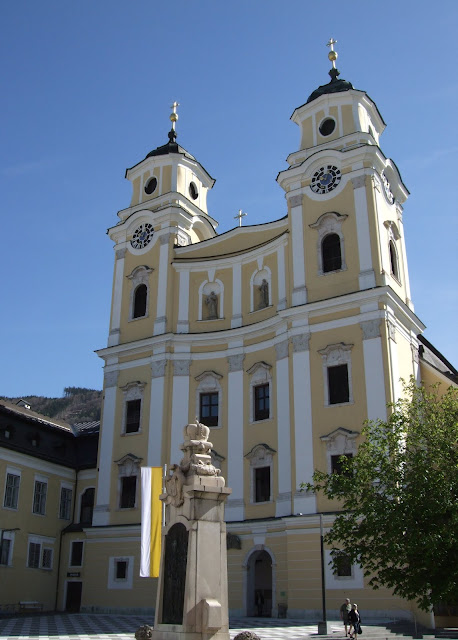 |
Basilica Mondsee.
The wedding church from the film "Sound of Music" (1965) where the Governess (Julie Andrews) and Georg von Trapp (Christopher Plummer) married.
The Governess/Nun & the Captain fell in love and married. On return from their honeymoon the Captain was required to join Nazism the German Navy. While performing at Salzburg Music Festival a plot to escape was successful as they "climbed every mountain".
|
 |
| Peter & Joy in Basilica Mondsee, Austria. |
 |
| Interior Basilica at Mondsee. |
 |
| Lake District en route to Salzburg. |
 |
Lake District, Austria.
We left "Imagery" at Linz to take a 10 hour tour to Salzburg and joined "Imagery" again at Passau. |
 |
| Austrian Alps from the bus. |
 |
| Salzburg. |
 |
Mirabell Gardens where "Do-Re-Mi" was filmed
with the children stepping down the stairs, running around the statues and fountain. |
 |
"16 going on 17" from Sound of Music
where the children were filmed running amongst these trees. |
 |
| Residenz fountain where Maria splashes water on the horses sing "I have confidence". |
 |
| Domplatz where Sound of Music was filmed with Franciscan Church behind. |
 |
Domplatz Arches where Maria runs through singing "I have confidence".
The arches connect Domplatz and Redisenz. Cathedral on right. |
 |
Salzburg Cathedral. Finished being built 1628.
Dome was damaged WW11, restored 1959. |
 |
Salzburg Cathedral.
Finished being built 1628, dome damaged WW11, restored 1959. |
 |
| St Peter's Cemetery & Catacombs where the Von Trapp family hid from the Nazis. |
 |
| The cemetery where the Von Trapp family hid from the Nazis. |
 |
| Joy hiding amongst the graves at the cemetery. |
 |
Mozart's birthplace. His family lived there 1747 - 1773.
The Composed and Pianist was christened |
Johannes Chrysostomus Wolgangus Theophilus Mozart.
 |
| The house where Mozart grew up with his family 1773-1780. |
 |
Wolfgang Mozart born 17 January 1756.
Married Constanze Weber (1762-1842) and had 6 children.
Died 5 December 1791. |
 |
| Salzburg is an enchanting city with its cobble-streets. |
 |
| Salzburg. |
Passau, Austria.
We left "Imagery" in Linz for our day excursion to Salzburg. Meanwhile "Imagery" cruised onto Passau where we joined in on our return from Salzburg. Joy had a quick walk around Passau and nearly missed "Imagery" before it departed.
 |
| The fortress in Passau high over the Danube was begun in 1219. |
 |
| City Hall Passau, built 1892. |
 |
| Hotel Wildes Mann, Passau. |
 |
Leaving Passau with the Town Hall towering over the village.
St Stephen's church (behind the Town Hall) has the largest organ in Europe,
having no less than 17388 pipes and 231 registers.
|
Regensburg, Austria.
 |
The Castra Regina Roman Fort - 179AD. Abandoned about 400AD.
Regensburg was the 1st Capital of Bavaria in 6th Century.
UNESCO World Heritage Site since 2006.
1245-1830 Free Imperial City directly answerable to German Emperor. |
 |
| St Peter's Cathedral began 1260. |
 |
| Pope Benedict XVI visited Regensburg 12 September 2006. |
Regensburg claims to have the oldest boy's choir in the world with a 1000 year history. The boys choir can be heard every Sunday in St Peter's Cathedral. Poe Benedict XV1's brother was a choir master for many years.
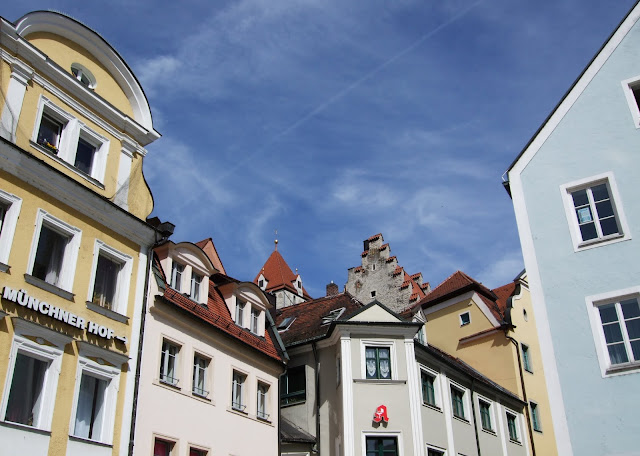 |
| Roman, Romanesque & Gothic architecture. in Regensburg. |
 |
| Regensburg. |
 |
City Hall built 1360.
The 8 floor tower was built 1250. Holy Roman Empire Parliament 1663-1806.
|
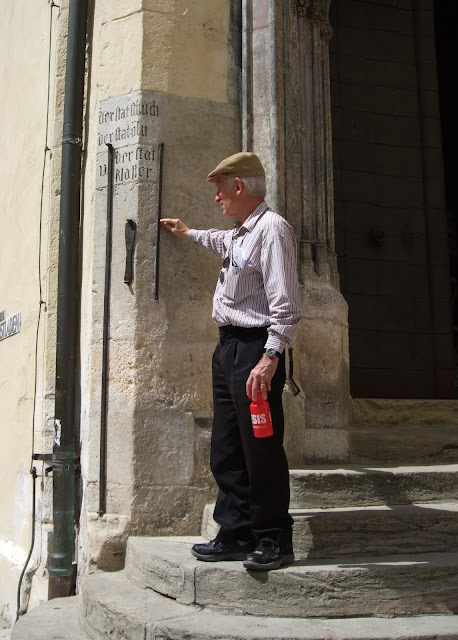 |
| Peter observes the local unit of measurement at City Hall entrance. |
 |
| Mosaic Coat of Arms in the floor of the City Hall dating 1718. |
 |
Regensburg was celebrating the "first of the season" beer.
The Mayor opened the keg and beer was poured into individuals beer steins.
The Market Place was full, a band playing and a time of festivity. |
 |
Germany's oldest restaurant - a 12th century historic "Old Sausage Kitchen".
The 900 year old building has been serving sausages and sauerkraut all those years.
Only sausages are on the menu and are served 6, 8 or 10. |
 |
| Of course we all enjoyed sausages at the "Old Sausage Kitchen". Recipe from 1256. |
 |
Entrance to the Old Stone Bridge, constructed 1135 - 1146.
|
 |
| Old Stone Bridge in Regensburg. |
We left the cruise at Regensburg and continued our tour by coach to Prague, Czech Republic.
Terezin Concentration Camp, Czech Republic.
 |
Cemetery at Terezin Concentration Camp with Christian Cross and Jewish Star.
Jewish - 9000 victims died 1st year of Ghetto.
Crematorium burn 30,000 corpses 1942-1945. |
 |
Block A.
The Nazi's used this camp as a "model camp" for the International Red Cross
as to how well the prisoners were treated! |
 |
About 30 women slept here without heating or lighting.
|
A sobering sight to visit one of the most notorious Nazi Concentration Camps in Central Europe. We learnt about the tragedy of Holocaust and Hitler's ideas of presenting the gruesome site of terrible human suffering as a popular holiday resort to the rest of the world. More then 150,000 Jews were sent there. Although not an extermination camp, about 33,000 died in the Ghetto. 88,000 were deported to Auschwitz. At the end of WW11 there were 17,247 survivors. The museum was interesting.
 |
Delousing equipment.
Delousing happened once every 3 months. In the morning the prisoners came into the room and had to take off all their clothes which were put into the delousing equipment. While that was happening they showered together and passed to the other side.
|
 |
Delousing Showers.
The prisoners were given their clean wet clothes to put back on as they had one set of clothes. With wet clothes they went straight out to work in the cold and many died after delousing.
|
 |
Cell windows opened to allow prisoners in the cells
hear other prisoners being tortured in the courtyard. |
 |
| Underground passage at Terezin. |
 |
| Cell Block. |
 |
| Cell. |
 |
| Prisoners files. |
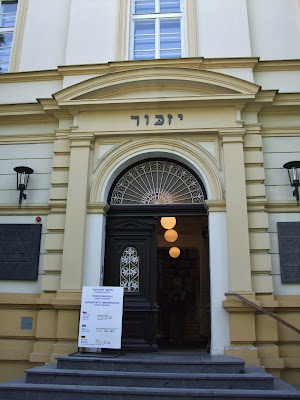 |
Jewish School now Ghetto Museum.
Prague, Czech Republic.
|
 |
| Ghetto Museum. |
 |
| Hradcany Castle gardens in Prague. |
 |
| Hradcany Castle gardens in Prague, with Hradcany Castle, Senate buildings and St Vitus Cathedral are a complex fortification high on the hill. |
Prague has 4 Districts: Castle District, Lesser Town (Jewish Quarter), Old Town and New Town Districts, united in 1784. Prague declared capital of Czechoslovakia in 1918. 1938-45 Hitler's forces occupy Czechoslovakia. 1993 Prague becomes Capital of Czech Republic.
Castle District.
 |
Entrance to Senate Parliament of Czech Republic.
Their first elections were held 1996.
|
 |
| 17th century Main Hall in Senate building. |
 |
| Ceiling in Leather Parlour of Senate building. |
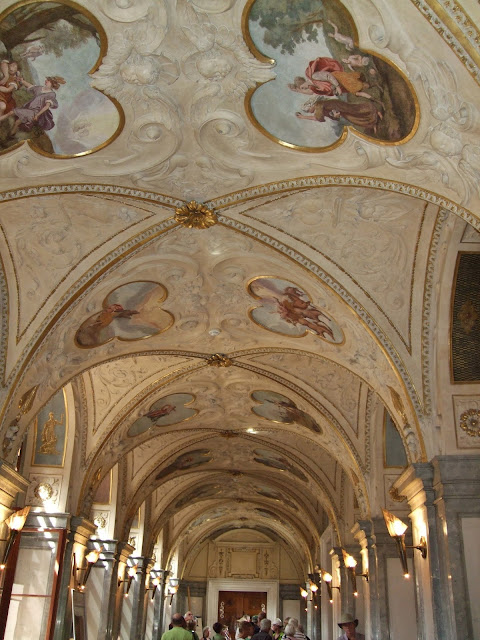 |
| Ceiling of Mythological Corridor of Senate building. |
 |
| Royal Palace. |
 |
| Steps into Vladislav Hall which horse and rider used. |
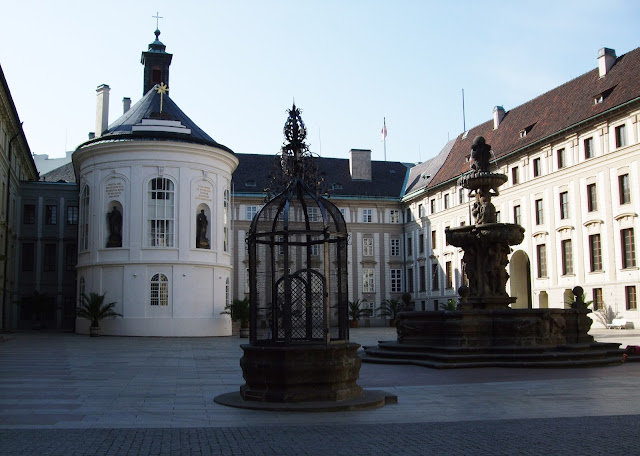 |
| Courtyard 11, fountain and Chapel of Holy Cross at Royal Palace. |
 |
| St Vitus Cathedral & interior a UNESCO World Heritage site. |
 |
| Interior St Vitus Cathedral. |
 |
| St George's Bascilica with Towers of Adam and Eve. |
 |
| Castle District. |
 |
| Castle District. |
Lesser Town.
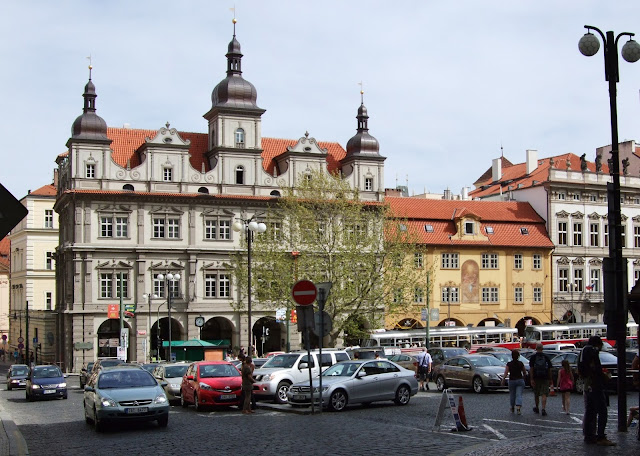 |
| Malostranske built 1478 as Town Hall for Lesser Town. |
 |
| Stature in Lesser Town. |
 |
Old-New Jewish Synagogue completed 1270.
Europe's oldest active Synagogue in Josefov. |
 |
Jewish Cemetery 1439-1787.
|
 |
Jewish Cemetery with 12000 tombstones
and many more burials. |
 |
| Peter and Luke had a good chat about their faiths. Levi was a Jew. |
 |
| Some of Levi's Jewish items. |
 |
| John Lennon (Beetles) Memorial Peace Wall to free speech for Czech youth (1980) in Lesser Town. |
Old Town.
 |
| Old Town Hall Square with many exquisite buildings. |
 |
| Old Town Hall Square with Church of our Lady of Tyn 1256-1450s. |
 |
Old Town Hall Square.
St Nicholas Church completed 1735. 1870-1914 Russian Orthodox.
After WW11 handed to Hussite Movement. |
 |
Astronomical Clock 1410 - oldest working clock in the world.
Calendar dial with medallions representing each month.
A dial representing position of sun & moon. Walk of Apostles on the hour. |
 |
| Astronomical Clock in Prague. |
 |
Walk of the Apostles on the hour.
Dial representing the position of the Sun & Moon. |

Old Town Square where Mikulas is celebrated on 5 December.
It marks the start of Christmas.
 |
| Old Town Square and St Nicholas Church. Completed 1735. |
 |
Charles Bridge over Vltava River, Prague.
Prague experienced their hottest April day on record - 32C.
When I was packing I was mindful of preparing for cold weather,
little expecting a heatwave, so did not have sandals. Never again. |
 |
| Charles Bridge is UNESCO listed and has over 30 statues. |
 |
There were youth protesting with placards & flags on the Charles Bridge.
Up to 200 Police were shoulder to shoulder & 50-100 Riot Police there to keep control. |
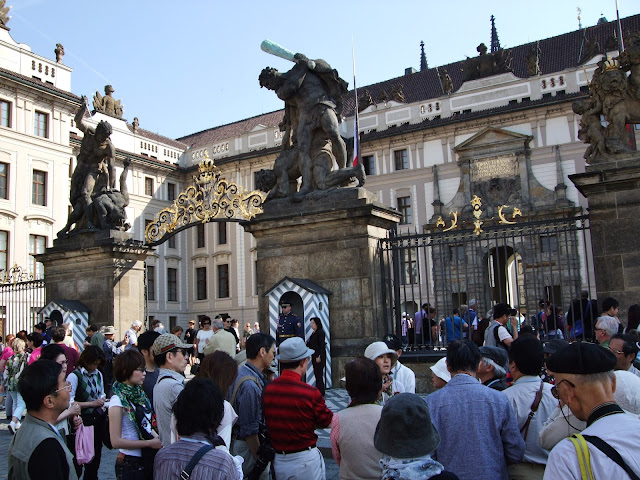 |
| Courtyard of Honour. |
 |
| Peter at Courtyard of Honour. |
 |
| Having pizza out near the clock. |
 |
| Opera House with cantilevered verandah. |
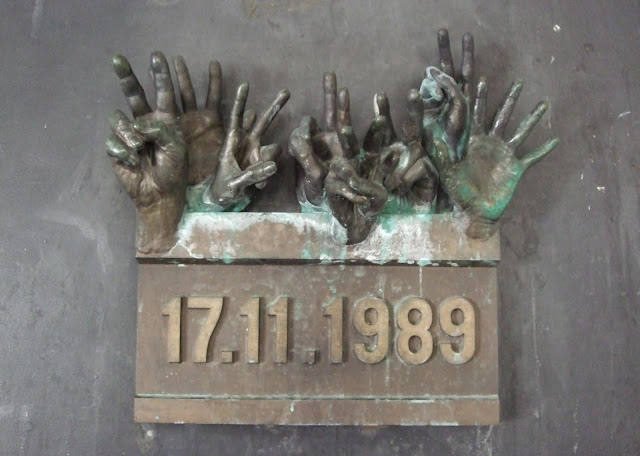 |
| 17 November 1989. Czech youth remember the struggle for freedom and democracy. |
 |
| Our last night in Prague and pizza again. |
 |
| Art outside our Intercontinental Hotel in Prague. |
 |
We said out goodbyes to Rob & Ruth Runkle who live in Arizona, USA.
(We did visit them in 2015). |
 |
| Last look at the Cathedral and Palace before leaving our Hotel in Prague. |
 |
Prague Railway Station. We took a 2 hour 15 minute train trip to Dresden, Germany.
|
 |
| Prague Railway Station. |
 |
| 1st class train travel Prague to Dresden, Germany. |
Dresden, Germany.
 |
Very scenic train trip to Dresden. Lots of community gardens for "weekenders".
Many people have no gardens, so these small community garden plots are very popular.
Lots of solar panel farms also, but we hear they have not been profitable. |
 |
| Zwinger Palace built 1710-1732 with Crown Gate. |
 |
| Zwinger inner courtyard and Rampart Pavilion (right) built 1710-1728. Baroque architecture. |
 |
| Semper Opera House built 1836 by Semper. Destroyed WW11, reopened 1985. |
 |
| Cathedral (left) and Palace (right) |
 |
Cathedral of the Holy Trinity (Catholic), built 1738, destroyed WW11, restored 1980.
Cathedral of Dresden since 1980. Largest Church in Saxony. |
 |
Original Royal Palace built 15th century.
Royal Palace destroyed WW11, reconstructed as Cultural and Museum complex in 2006.
Haussman Tower restored 1991. |
 |
| Courtyard and Langer Gang leading to stables. |
 |
| Palace complex with Museum. |
 |
| Procession of Princes. A Mural of 101 metres long. |
 |
| Process of Princes. |
 |
Originally State Parliament 1907-1934.
Destroyed WW11, Museum till 1999, now Court of Appeal. |
 |
Lutheran Church of our Lady, built 1726-1743, destroyed WW11,
reconstruction began 1994 and completed 2005. |
 |
| Joy and Martin Luther outside Lutheran Cathedral. |
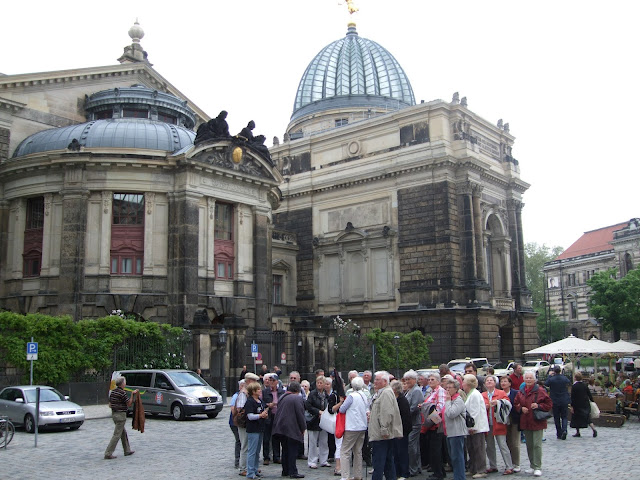 |
Academy of Fine Arts with lemon squeeze domes.
Built 1894, destroyed WW11 and restored 1991. |
 |
Church of Holy Cross, destroyed WW11, exterior restored 1946-1955.
Interior partially restored from 1995, plain and simple.
|
 |
Interior Church of Holy Cross.
We bought a 24 hour tram ticket - very convenient and cheap way of getting around Dresden to see other sights.
|
 |
Volkswagon's Manufacturing Plant. The factory is of glass exterior.
A large and fascinating building where one can see the automotive assembly up close.
A showroom of class and first class restaurant. A sight to behold at night with all its lights on.
|
 |
"Golden Horseman".
Famous statue of August 11, King of Poland, died 1733. Statue cast 1736. |
 |
Bird & Augustus Bridge.
|
 |
| Elbe River. |
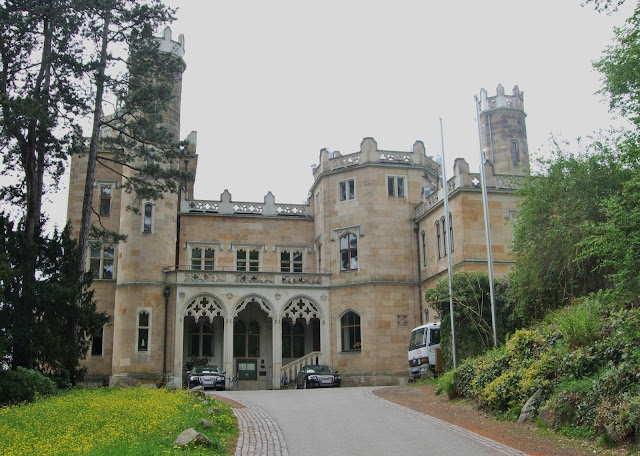 |
Old Riverside Palace built in middle of 19th century. Now a Restaurant.
There were 3 old Palaces in the area. |
 |
| Met in Dresden Mel and Anne who were on our river cruise. (Mel was a contact of Darren's). |
 |
We travelled by Eurail from Dresden to Bayreuth (3 hours 15 minutes).
Very scenic with rape seed and small villages.
|
 |
Fields of Rape seed.
|
 |
| Community gardens. |
Bayreuth, Germany.
We spent 3 nights with Connie & Harald Franz and daughter Antonia in Bayreuth, Germany. Antonia stayed with Darren & Fiona for 2 month in 2011. In 2004, daughter Moni stayed with Darren & Fiona for 6 months. The Franz family were keen to return some hospitality. We were very warmly welcomed.
 |
Connie & Harald Franz took us to a Beergarden in Bayreuth for a real German experience.
We ate a variety of meats, cheese and bread. A German band was playing and we danced. |
 |
| Dancing at the beergarden. |
 |
| Home of Connie & Harald Franz. |
 |
| German breakfast in the sunroom. |
 |
| Peter & Joy in Bayreuth. |
 |
| Peter & Antonia walking through Bayreuth village. |
 |
| Bayreuth village. |
 |
The original Old Palace was built in 1715 and was destroyed by fire in 1753.
This building was rebuilt in 1950 after WW11 damage.
Although "new", it is still called the "old" Palace. |
 |
Margravial Opera House was initiated by Margravine Wilhelmine
with construction beginning in 1744 and completed 1748.
In the 18th century to have an opera house as large and magnificent
built in the small residential town of Bayreuth set it apart. |
 |
| Margravial Opera House - an UNESCO World Heritage Site. |
 |
Fama figures hovering above the proscenium arch with margravial coat of arms.
Queen Wilhelmine & King Friedrich Coat of Arms.
Queen Wilhelmine died 1758.
|
 |
| Entrance - Monument of European Theatre architecture. |
 |
Tiers of viewing boxes made entirely of wood.
|
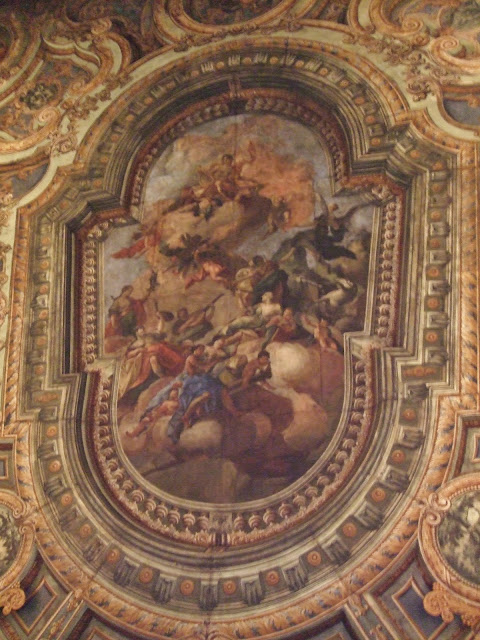 |
| Ceiling in the Theatre. |
 |
The presence of the Margravial couple was as important as the theatre performance.
Preserved in its entirety, the opera house is one of the few remaining 18th century theatre buildings in Europe. The interior is totally of timber and incredibly magnificent. |
Then we went to Richard Wagner's Festival Theatre, also in Bayreuth.
 |
Composer Richard Wagner's Festival Theatre, open 1876.
Personally designed by Richard Wagner with perfect acoustics.
Adult Hitler frequently attended performances at Festival Theatre. |
 |
| Interior Festival Theatre. |
 |
We went backstage. Peter conducting!
We went to New Hermitage Palace which was presented to Wilhelmine in 1753 as a gift from her husband Margrave Fredrich. The attached Sun Temple is crowned with the Sun Chariot of Apollo.
New Hermitage Court Gardens - Harald, Antonio, Peter & Connie. Avenues, hedge gardens, pergolas and water works made the New Hermitage Gardens unique amongst gardens in the 18th century as there were no gardens of this type in Germany.
|
 |
| New Hermitage Palace 1753. |
 |
| Sun Temple is crowned with the Sun Chariot of Apollo. |
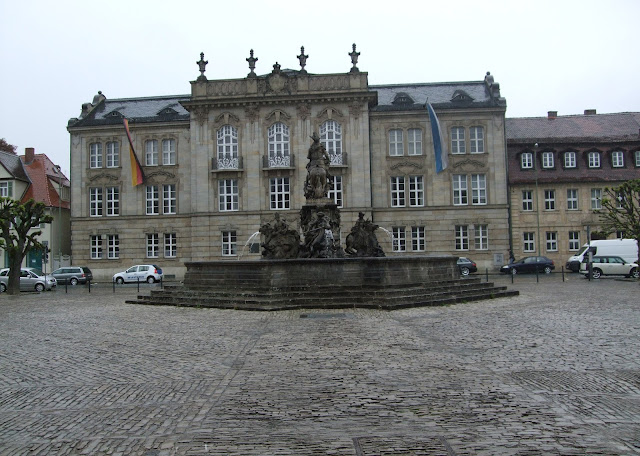 |
New Palace built 1753 after the Old Palace was destroyed by fire.
Margrave's fountain in front of the New Palace.
|
 |
| Dinner with Connie & Harald & daughter Antonio at Bayreuth. |
Bamberg, Germany.
 |
| Raining again but did it matter?! We had a wonderful day in Bamberg. |
 |
Bamberg's signature photo - UNESCO World Heritage town.
Bamberg's old Town Hall. The Bishop refused to give land to build a Town Hall.
Citizens made an artificial island on River Regnitz to build their Town Hall. |
 |
Old Town Hall Tower built 1836.
Old Town Hall houses Ludwig Collection of tureens and figurines. |
 |
| Frescoes painted on Old Town Hall in 1755. |
 |
| Bamberg with Old Town Hall & Tower. |
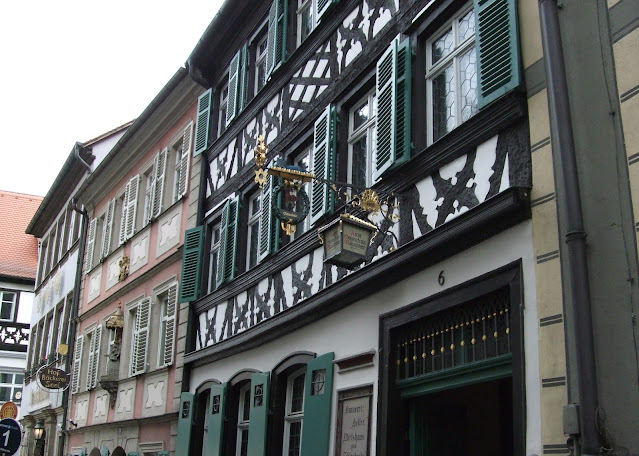 |
| Bamberg's famous Brewery. |
 |
| Bamberg. |
 |
| Bamberg. |
 |
The day we visited Bamberg Cathedral was their 1000th anniversary.
This 3rd Bamberg Cathedral was consecrated 6 May 1237 - 775 years ago. |
 |
| Interior of Bamberg Cathedral. |
 |
| Altar & Choir stalls. |
 |
Tomb of Emperor Heinrich 11 and his Consort Kunigunde.
|
 |
Crucifxion of Christ with Mary, mother of Jesus & Mary.
|
 |
| Old Palace behind the Cathedral. Band playing but too wet to stop and enjoy. |
 |
| Coffee in Bamberg. |
 |
| A fantastic day in Bamberg. |
 |
Dinner and an opportunity to meet Fiona's friend Mia & Marcus & son Matthew.
|
 |
| Bayreuth. |
 |
We went to a concert at the Town Hall to see 4 talented female Musicians "Salut Salon".
|
Nuremberg, Germany.
 |
Here we come Nuremberg. We made good use of our Eurorail ticket.
Adolf Hitler commissioned the Nazi Party Congress Hall after monstrously successful Nuremberg rallies and prior to onset of World War 11. The documentation Centre Museum provides a sobering chronological reminder of Hitler's rise and fall and Nuremberg's pivotal yet unenviable role in Nazism from pre-war rallies to post-war trials. On 20 November 1945 world history was written in Nuremberg Palace of Justice. 21 leading representatives of the National Socialist regime were made to answer for their crimes against peace and humanity. October 1946 sentences were pronounced, either hanging or life imprisonment. |
 |
| Nuremberg. |
 |
| Holy Spirit Hospital and Pegnitz River. |
 |
| Nuremberg. |
 |
St Lawrence Church, Nuremberg.
A Protestant Lutheran Church, destroyed WW11, re-consecrated 1952.
Building began 1250 originally as 3 aisled basilica in high Gothic style,
later extended with Gothic hall choir (1439-1477).
Two towers 80 and 81 metre high are important works of art. |
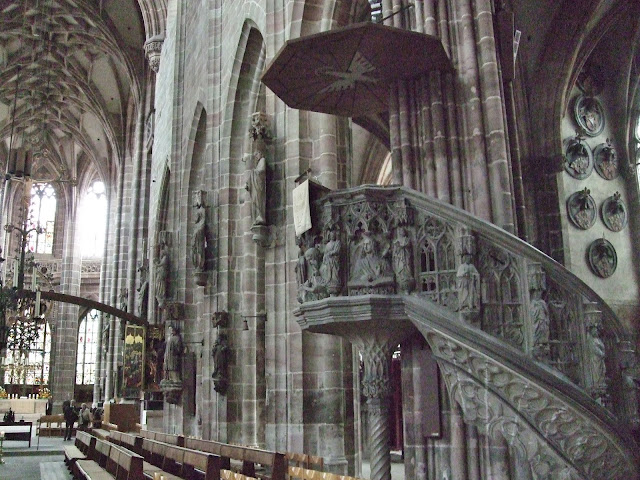 |
| Pulpit in St Lawrence Church. |
 |
The Tabernacle 1496 & Annunciation created 1518.
Medieval alters, memorial plaques, stained glass windows, pulpit - truly a magnificent building/church. |
 |
St Sebald (Protestant Lutheran) Church.
Built 1215 as a three-aisled Late Roman-esque pillared Bascilica with two choirs.
1309 the original side aisles were widened and altered in the Gothic style.
Destroyed during WW11. St Sebald was reconstructed in 1957 and reconsecrated. |
 |
| Interior St Sebald. |
 |
Residence of St Sebald's Protestant Clergy.
|
 |
Church of Our Lady (Roman Catholic).
Constructed as an Imperial Royal Chapel 1355/58 by Emperor Charles IV.
At noon every day the mechanical clock and glockenspiel recalls
the proclamation of Golden Bull of 1356. |
 |
Beautiful Fountain built 1385-1396.
Four rows of 40 stone figures represent the world view of the Holy Roman Empire.
St Lawrence in the background. |
 |
Imperial Castle surrounds Nuremberg old town.
Defensive chambers inside bastions led to medieval water supply conduits.
Imperial regalia was kept in Imperial Castle from 1424. |
 |
Imperial Castle. Bunker system 24 metre deep into Castle Hill.
Nuremberg's art treasures withstood WW11 bombs as they were hidden in the bunkers. |
 |
| Fortification of Old Imperial Palace. Note slots for guns. |
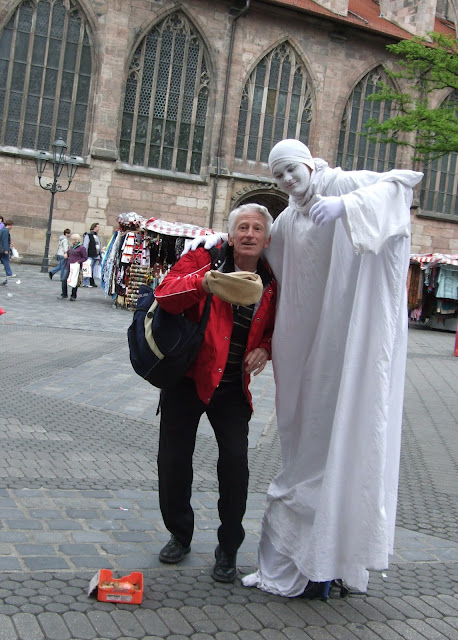 |
Busker outside St Lawrence Church.
Who should get my donation?!! |
 |
| Our fast train arrived in Nuremberg. |
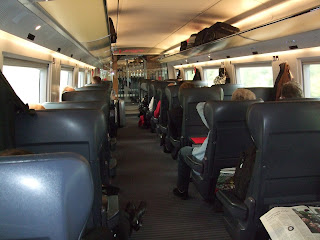 |
Travelling first class to Frankfurt.
|
 |
Frankfurt Railway Station.
We Eurailed from Nuremberg to Frankfurt - 2 hours 15 minutes. At times we travelled at 245km/hr. There was an escalator to take us from the Frankfurt Railway Station to Frankfurt Airport. Extremely convenient. |
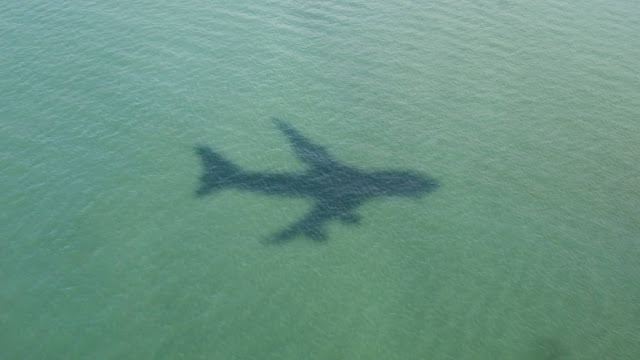 |
| A shark in the water! |
 |
Thank you Reginald Ansett for a safe flight home via Singapore,
arriving 9 May 2012 (exactly 4 years before Peter's death on 9 May 2016).
If you have any comments please email Joy Olney - joyolney@gmail.com |






























